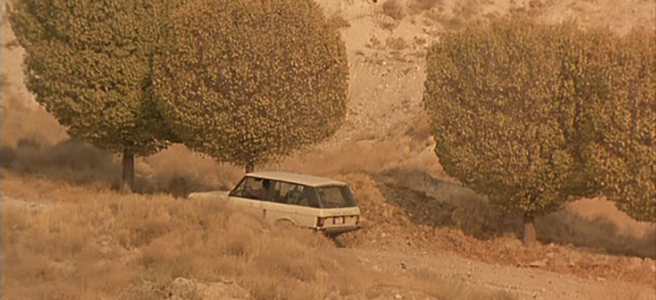“Change your outlook …” . This prescription is given to Badii by the Azeri taxidermist. Of the three passengers Badii picks up to solicit help in his plan for suicide, the taxidermist is the most vocal in his disagreement of Badii’s intentions. In sharp contrast to the young soldier, whose nervousness from Badii’s appeals made him tight-lipped and skittish, the taxidermist, an older, more reflective character, offers example after example of why life is worth living. But the taxidermist is also the one who agrees to go to the hillside with the hole under the tree and check to see if Badii is alive or dead. He also gets one additional chance to cancel his promise, because Badii returns to the taxidermist’s workplace to make a revision to the plan: the taxidermist is to throw stones and shake Badii, just in case he is not dead but asleep.
Contained in this partial summary of Taste of Cherry is the frustration you will feel watching this film. Badii’s reasons for suicide are never given, and the behavior of a life-affirming character like the taxidermist compounds the mystery of what is going on. Over an hour into the film, the viewer is not surprised that Badii does not change his mind to execute the plan to go to the place where he will decide his fate, but the taxidermist has just met Badii. What does the taxidermist see in Badii? Does he think it is necessary for Badii to go as close as he can to attempting suicide?
When I say Taste of Cherry is frustrating to watch, I sincerely mean “frustrating”, yet I am using the word for the purpose of recognizing Kiarostami’s genius. In other words, Roger Ebert’s infamous review of Taste of Cherry is right, but for the wrong reasons. When Ebert grew impatient with what Kiarostami withholds from the viewer–character background and the causes of suicidal ideation–he was right to want more from the film; but he was surprisingly reluctant to think through his feelings of frustration, to find the connection between the aesthetics of Taste of Cherry and this angry desire to know if the life of Badii is worth living or not.
Taste of Cherry puts the audience in a state that is intimately familiar to those who have experienced suicidal thoughts (which I have). In order to continue to live, you have to change your outlook (to put it very mildly), but the whole process of affirming life cannot function like the balance sheet of an accountant. There is no utilitarian sum or product to indicate the exact point when you have accumulated enough reasons to live. Is the taste of mulberries enough of a reason? Mulberries and cherries?
Then comes the controversial ending of Taste of Cherry. With one more parry, Kiarostami has you stumbling from your interest to know what will happen to Badii lying in the hole under the tree. Badii enters the hole at night and in a slow zoom towards the hole’s pitch-black opening, we anticipate we will see what comes after. CUT TO: camcorder footage of the same hill in daytime, which suddenly looks greener than how it was filmed hitherto. This footage is documentary-like. It takes place on the central hillside of the film, but we watch Kiarostami talking with the actor who plays Badii. We are on the film’s set and not in the story itself.
I am repeatedly shocked by this ending. I now know that it is coming, but my brain can never time the cut to the camcorder sequence–much like how Geoff Dyer speaks about the transition from monochrome to color in Tarkovksy’s Stalker. Producing one more bout of shock in this film is incredible because it reminds you that you can’t help it: even after three open-ended conversations about Badii’s desire to die, you are searching for a logical cause-effect substratum. The taxidermist gave lots of reasons to live, and you desperately want to know if they were effective in reversing Badii’s plan. Incredible.

